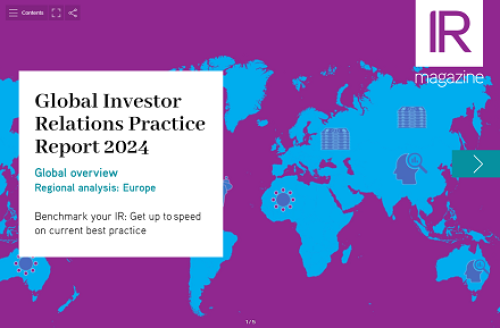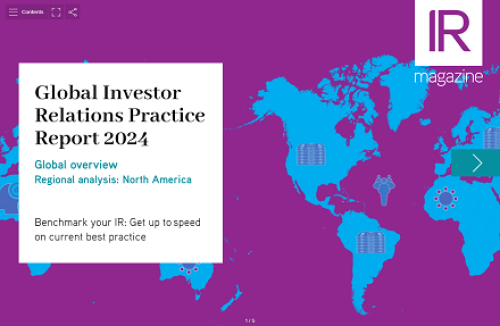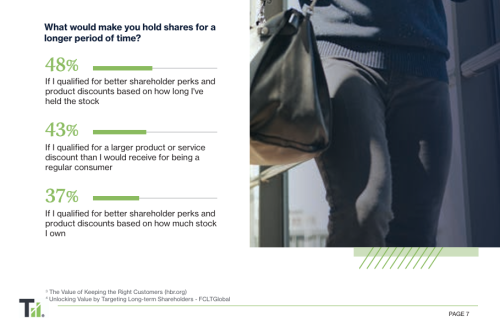Key findings from Thomson's IR practices study, based on responses from more than 560 IROs worldwide
The sell side
Conventional wisdom is that sell-side coverage is decreasing, yet many companies report an increase in the number of sell-side analysts covering their stock (46 percent). Meanwhile, 41 percent say they now spend more time communicating with the sell side. This is mostly due to high turnover on the sell side, which forces IROs to allot more time to explaining their company’s fundamentals to greener analysts.
Exactly how much time is spent with the sell side? Sell-side analysts tend to absorb 42 percent of an IRO’s communication time, while the buy side grabs another 55 percent. This skews higher at the 25 percent of companies that proactively seek to increase coverage. Most IROs (32 percent) are focused on maintaining current sell-side coverage.
Another notable trend: sell-side analysts are heightening their focus on the rapidly growing European markets, with 62 percent of European companies reporting an increase in sell-side coverage over the past year.
IR responsibilities
Many IROs were previously considered ‘gatekeepers’, but none consider that to be their role nowadays; it seems IR has evolved into a more strategic function. Management teams are now more supportive of IR: 87 percent of IROs say their management team views IR as ‘critical’, or is at least ‘supportive’ of the IR function, and 38 percent of respondents say their IR team budget rose in 2007 compared with 2006.
This is also reflected in new responsibilities: 61 percent of IROs say they have taken on new duties. In particular, 10 percent of all IROs report they are spending more time communicating internally, most often with the top brass. A further 10 percent of IR pros note an increase in time spent on competitive intelligence.
Evolving relationships
Beyond plain vanilla funds, institutions now include more hedge funds, quant investors, sovereign wealth funds and myriad other investor groups. More than one third of IR professionals say their interaction with hedge funds in particular has increased in the past year – so it’s not surprising that at the top of IROs’ wish lists is more insight into ownership, particularly who owns the stock and why. ‘The buy side is probably the most opaque part of the job,’ said one mega-cap financial company.
The types of questions asked by investors are changing, too. IROs need to be well versed in the financial performance of the company (43 percent say this is what investors ask about); they need to clearly articulate the company’s strategy (39 percent); and they must be knowledgeable about individual business operations or products (32 percent).
Interestingly, a handful of small-cap and micro-cap companies complain that investors are increasingly demanding information that would cause them to cross disclosure lines laid out under Reg FD.
The best/worst part of IR
For over half the IROs we spoke with, the best part of their job is interacting with investors and analysts: they enjoy working with an audience they consider to be ‘intelligent’ and ‘insightful’. Furthermore, they welcome the challenge of analysts’ questions and the external perspectives on their company this provides.Meanwhile, one third of IROs report that working with senior management and being involved in the core aspects of the organization is the best part of IR. As one large-cap telecoms IRO said, ‘The best part is the chance to work with a variety of very smart people, both on the Street and internally.’
Many IROs are still overwhelmed by their workloads: about a third describe this as the single hardest part of their job. In our study, IROs cite everything from the general 24/7 nature of the job to specific tasks like preparing scripts for earnings calls, scheduling and logistics for meetings, and proofing press releases.
While IROs mostly find dealing with the investment community a pleasure, that doesn’t apply to all investors. In fact, 21 percent of IROs say difficult investors are making the job harder, particularly hedge funds, activists and others with a short-term focus. As one IRO at a large-cap energy firm says, ‘The worst part is talking to hedge funds that do not want to understand the story and are just in the stock for a quick bump.’
The future of IR
We asked IROs to peer into their crystal ball and discovered that almost 20 percent believe IR will evolve into a still more strategic role, with 10 percent expecting little or no change in the function. Other themes include IROs becoming more financially savvy and leveraging the external perspectives gleaned from the investment community to assist with corporate strategy, and the challenge in articulating and controlling a clear message in the face of ever-increasing demands for guidance and greater disclosure than IROs are willing to provide. Seventeen percent say the most challenging aspect of IR in future will be the proliferation of non-traditional investors, most notably hedge funds.
One small-cap healthcare IRO sums it up: ‘IR is going to become more integrated with corporate strategy because investor perceptions are important for a public company.’ In fact, 13 percent of IROs believe IR will ascend the ranks and become more integrated with management teams.
Thomson Financial surveyed IROs at more than 560 companies worldwide for this research. For more details, visit thomsonfinancial.com/insight.










